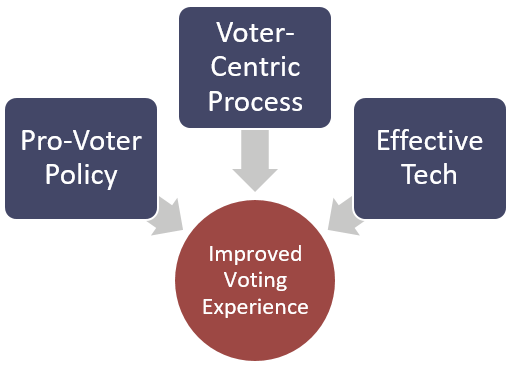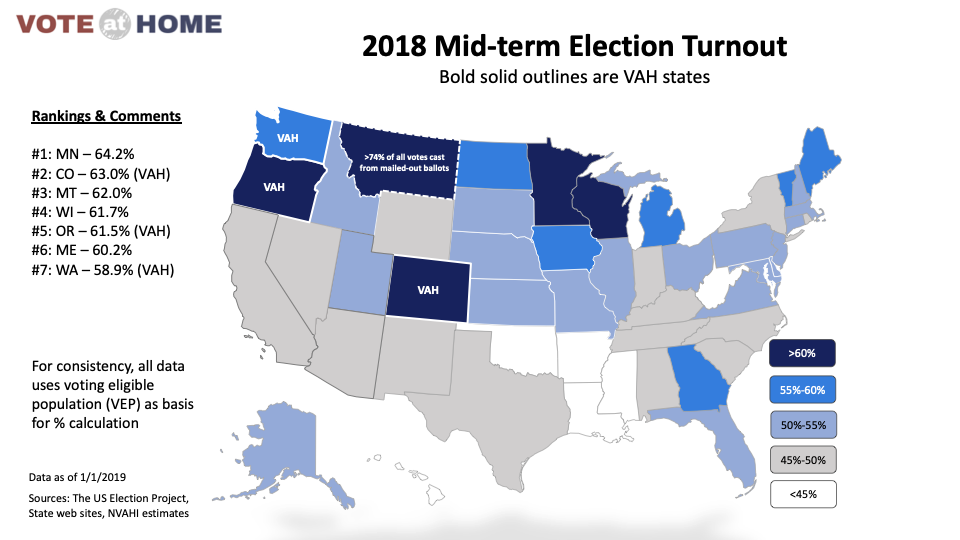Elections Are Broken Because They Aren’t About the Voters

A line to cast their ballots in the 2016 United States Presidential Election in Mount Pleasant Township, Adams County, Pennsylvania. Bill Dowling / Shutterstock.com
COMMENTARY | To improve our election system, let’s focus on who votes, not who wins.
It should be no surprise that the 2018 November election was full of headlines about long lines, inconvenient voting processes, barriers to access, machine and system malfunction, and other difficulties.
Our election system was never designed for voters. It was designed to meet the needs of political parties, campaigns, elected officials, and vendors. But a great place to start fixing the problems seen year after year across this country, and highlighted again last fall, is election administration—the actual customer service process that is the voting system.
Improving the voting experience requires a specific approach that puts the voters first.
And it starts at the beginning: registration. Disconnecting the voter registration process from the act of voting and casting a ballot is inherently flawed.
The way this process exists in many states is because the system was designed so that candidates had a roster of voters ahead of time who they could reach out to for their campaigns. But states with 30-day deadlines, as an example, have a myriad of inefficiencies. Higher provisional ballots cast and higher customer calls from voters showing up at the wrong polling places produce higher costs and are wholly ineffective for administrators and voters alike.
However, with advancements in technology, there are better ways to register voters. Automatic voter registration, which exists in 15 states and the District of Columbia, means that residents are registered to vote when they show up at any government agency, unless they decline. The automated process also increases the accuracy of the address information on file for each voter.
It should be no surprise that automatic voter registration is more efficient, more secure, and more accurate than the usual paper process—just think about the difficulty of deciphering handwriting scribbled on clipboards. Voter registration deadlines are also inefficient (and, frankly, disrespectful to voters).
We also have had a history of spending money on voting equipment without considering the actual process first. Case and point, after the debacle in Florida in 2000, there was a tremendous rush to replace voting systems with a quick infusion of money from Congress. This is the classic mistake of throwing money and technology at an inherently flawed process. You may not be surprised that some of the vendors that ultimately built the voting systems as a result of the 2002 authorization also lobbied on what was required to be in the law—and still lobby today to influence voting policies, not necessarily with the voter’s best interests in mind, but rather their shareholders.
This includes lobbying against reforms like automatic ballot delivery (known as, “Vote at Home” or / “Vote by Mail”) or expanded early voting. And why? By spreading the voting process over a longer period of time, the need for election day equipment is reduced, thus saving jurisdictions money but also reducing the bottom line for a vendor who produces machines.
The result is new equipment and systems that further compound and complicate the voting process without actually addressing the core problems, like long lines at the polls, that frustrate voters. With technology implementations, you first must learn the process, create a voter-centric design, and then develop technology to support the lean and efficient process.
Automating a bad process with technology does not solve problems and is a good example of why the same voting problems resurfaced this year.
There is a straightforward, proven solution—and the formula and the sequence matters tremendously: Pro-voter policies + voter-centric processes + effective technology = improved voting experience.
This is the approach we took in Denver with Ballot TRACE, eSign and implementing a new voting system.
Additionally, this was the same approach we used to modernize Colorado’s election process in 2013. Start with passing pro-voter reforms, develop voter-centric processes to implement the reforms, build effective technical systems to support the process and you will improve the voting experience. This is exactly what has happened in Denver and across Colorado.
In terms of pro-voter policies, it should be of no surprise that states like Colorado, Washington, and Oregon, which have seamlessly connected voter registration with balloting, continue to lead in voter engagement. All three were in the top seven states for turnout and, collectively, their turnout was 60.9 percent of voting eligible population versus the rest of the states averaging 48.9 percent.
Here is a map that shows midterm turnout across all 50 states:
In Colorado, as in other Vote at Home states, a ballot is automatically mailed to every active voter before each election. It is not unlike ordering a product online from Amazon or another store.
You complete the order and enter your address information, then your product is mailed and you receive tracking information as it is in process, and your product (in this case, the ballot) arrives.
You then have time at home to complete ballot, and perhaps research issues or candidates, and you are empowered to decide when, where, and how long you spend voting. Then you submit the ballot back to election officials and the ballot is processed and counted in a central location. After the election, risk-limiting audits are conducted to confirm the accuracy of the results.
As you can see, we have seamlessly connected voter registration with the actual balloting process. This has streamlined the process for voters and administrators alike. And the results are impressive—higher voter engagement, Colorado had the second highest turnout in the country and the highest voter registration rate, and also became one of the most secure states to vote in.
Now, to be sure, traditional vote by mail methods can be implemented poorly. We just saw examples of this in North Carolina’s 9th Congressional District, where the illegal collection—and, at times, completion—of absentee ballots recently led regulators to call for a new election. The issue in North Carolina was not the ballot delivery policy itself but rather a combination of missing elements that are critical to implementing an effective vote at home/vote by mail system.
First, ballot tracking systems are critical to informing voters about the status of their mail ballot throughout the process. Second, offering voters options to drop-off their ballots is also important, so that they do not need to rely on someone else to assist. Third, educating voters on the process and how to identify and report nefarious activity helps ensure the integrity of the voting process. Criminal penalties to protect voters and to disincentivize bad behavior are critical.
Finally, civic design is a vital and often overlooked element to an effective ballot delivery system. Election officials must consider clarity and usability when designing their ballots, instructions and other materials. Ballot design was flagged as a problem in both Georgia and Broward County, Florida during the November election. But officials can reach out to groups like the Center for Civic Design, which has produced some outstanding resources in the past few years, helping jurisdictions design their materials more effectively.
To solve the challenges that continue to plague the voting process, we need to re-design our approach and adopt proven solutions. States need to look to vote-at-home systems that exist in Colorado, Washington and Oregon—as well as other states that are implementing or have wide use like California, Utah, North Dakota, Montana and Arizona.
Vote at home solves so many of the issues that continue to plague elections across the states: ridiculously long lines, high numbers of unnecessary provisional ballots, massive numbers of calls to election officials confused about where to go, machine malfunctions, security, accuracy of address lists, and finding enough poll workers.
Beyond all those hassles and concerns, it also solves for the most pressing issue: inconvenience to the voter, which is one of the top issues non-voters cite as a reason they did not vote.
So, let’s make the election process pro-voter and customer-centric. Let’s develop effective technology to support the voter and the process, as opposed to throwing technology at age-old process flaws. The actual and perceived integrity and trust in our election system is the foundational premise for our system of self-government. The first interaction voters have with their elected representatives is during the voting process. Think of it as your first encounter with a store or with a company—how was the customer service?
If it was bad or challenging, you are less likely to go back to that store or use the service again. It’s the same with voting. If voters have a challenging experience, their first impression of government is not positive.
Let’s make the voting process one that is celebrated by all voters regardless of their political persuasion. Just as it has in Colorado, system reform will improve the voting experience, increase public trust in the election process and enhance trust in government and political systems broadly.
Amber McReynolds is executive director of the National Vote At Home Institute, a nonprofit dedicated to ensuring the security of our elections and putting voters' needs first.
NEXT STORY: A Health Department Tackles Recidivism







